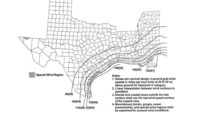Roofing Code: Section 1504.7 Impact Resistance

1504.7 Impact resistance: Roof coverings installed on low-slope roofs (roof slope <2:12) in accordance with Section 1507 shall resist impact damage based on the results of tests conducted in accordance with ASTM D 3746, ASTM D 4272, CGSB 37-GP-52M or the “Resistance to Foot Traffic Test” in Section 5.5 of FM 4470.
Code Interpretation:
The code implies that all roof covering materials installed on low-slope roof systems shall be tested to determine impact resistance. The impact resistance tests shall be completed in accordance with ASTM D 3746 and/or ASTM D 4272.
ASTM D 3746 is titled “Standard Test Method for Impact Resistance of Bituminous Roofing Systems.” This test is completed by placing a steel cylinder (2 inches wide and 6 inches in length) in a vertical guide tube (4 feet long with 2 3/8-inch diameter). The guide tube is placed a minimum of 53 inches above the test surface. The missile is released to fall and strike the test specimen. A total of four tests — one in each quadrant — are required for each test specimen. At the conclusion of the tests the impact areas are examined for damage. The specimen is rated for impact damage per component. The rating system is as follows:
0 = no damage
2 = dents, indentations only
4 = any cracks or splits
The ratings are applied to each component (plies) in each quadrant, added up and then divided by four times the number of plies to obtain the average for the membrane.
ASTM D 4272, “Standard Test Method for Total Energy Impact of Plastic Films By Dart Drop,” uses the same premise; however, a dart is used as the missile to test pinhole impact.
Looking for a reprint of this article?
From high-res PDFs to custom plaques, order your copy today!






